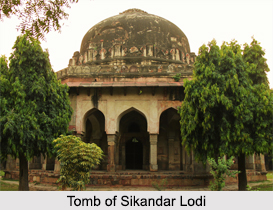 Sikandar Lodi was nominated by his father Bahlul Khan Lodi to be his successor. He was the second ruler of the Lodi dynasty and proved himself to be the most capable son of his father. He destroyed the powers of the nobility, finished all rebellious nobles and forced others to respect and obey him as a Sultan. He is rightly claimed to be the greatest Lodi Sultan. He succeeded more than his father in extending the empire and restoring the prestige of the Sultan.
Sikandar Lodi was nominated by his father Bahlul Khan Lodi to be his successor. He was the second ruler of the Lodi dynasty and proved himself to be the most capable son of his father. He destroyed the powers of the nobility, finished all rebellious nobles and forced others to respect and obey him as a Sultan. He is rightly claimed to be the greatest Lodi Sultan. He succeeded more than his father in extending the empire and restoring the prestige of the Sultan.
His elder brother Barbak Shah, the viceroy of Jaunpur also claimed the throne and thus they two got involved in a dispute. However, Sikandar Lodi could get rid of his trouble and was able to claim the throne through delegation. He allowed his brother to govern Jaunpur. Sikandar Lodi conquered Bihar and Tirhut which were significant in his extension of Empire. Sikandar Lodi also succeeded partially against the Rajput state. He conquered Dholpur, Mandrail, Utgir, Narwar and Nagaur. He defeated the ruler of Gwalior occasionally but failed to annex Gwalior in his territory.
Sikandar Lodi was an able administrator and tried his best to deal with the rebellious and independent nature of his own Afghan nobles. He framed definite rules which were observed by all the nobles and governors to honour the Sultan. Sikandar made no distinction between the rich and the poor while giving out justice. He organised a proficient surveillance system which helped him to keep the nobles under his dominion. All these measures succeeded and Sikandar Lodi was successful in controlling tendencies of tribal independence of his nobles.
Sikandar Lodi was the greatest king of the Lodi dynasty. He was very well educated and was accepted as a scholar. He honoured learned men, encouraged education especially among children of his afghan nobles so as to make them cultured. He tried to convert mosques as centers of education, built them on a large scale and appointed one religious preacher, one teacher and one scavenger in each of then as state expenses. His court became a center of learning due to his patronage to scholars. He called two eminent philosophers Sheikh Abdullah and Sheikh Azizullah from Tulamba to improve the system of education in his Empire. Many scholarly works in Sanskrit was translated into Persian during his time. Sikandar Lodi patronised fine arts as well. He was interested in music and enjoyed Sehnai very much. He built many mosques, a tomb at the grave of his father and the city of Agra.
Sikandar Lodi was a laborious, generous and just ruler. He was free from debauchery and was a religious minded person. He distributed free food and clothes to the poor lavishly. He ordinarily practiced the principles of Islam in his daily life but was not a strict puritan. He believed in quick dispensation of justice and one qazi and twelve ulemas were always present in his palace to decide cases. Sikandar`s justice was stern but was not at all vindictive. He abolished Zakat (import duty) on grain and prices of all necessary articles remained low during his period so that people of even moderate means could live in comfort. The Sultan encouraged trade and agriculture which resulted in the prosperity of the state. He succeeded in providing security, peace, economic prosperity and justice to his subjects.
Sikandar Lodi was a good soldier and a successful commander. He was courageous and dauntless. He was engaged in constant fighting in order to extend his empire. He conquered Bihar, forced the ruler of Tirhut to accept his suzerainty and the ruler of Bengal accepted his friendship. In Rajasthan, he conquered Bayana, Dholpur, Etawah, Chandwar and Chanderi and collected tribute from the rulers of Gwalior and Nagaur. He succeeded in suppressing the revolts of Hindu chiefs in the Doab and finally annexed Jaunpur to his empire. Of course, these conquests and campaigns do not assign him the place of a commander, yet it is largely accepted that he was successful in extending the boundary of his empire and restoring the lost prestige of the Sultan.
One primary success of Sikandar Lodi was to keep his own Afghan nobles under his control. He eliminated all his rivals to the throne and determined opponents in the beginning of his reign. He respected the old and experienced nobles and never removed anyone from his assignments or snatched away his jagir until a fault was proved against him. Unlike his father, Bahlul, who remained content with the position of the first among equals, Sikandar pursued the Turkish and Hindu conception of sovereignty and kept his position superior to all as the Sultan.
Sikandar Lodi was a fairly successful ruler. Whatever he inherited from his father, he extended and consolidated. Sikandar Lodi died in 1517. His death was a loss to his subjects. The burial tomb of Sikandar Lodi is present at Delhi.



















